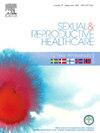Combining the antenatal risk questionnaire and the Edinburgh Postnatal depression scale as a psychosocial risk assessment tool in Danish antenatal care. A descriptive study
IF 1.7
3区 医学
Q3 PUBLIC, ENVIRONMENTAL & OCCUPATIONAL HEALTH
引用次数: 0
Abstract
Objectives
To evaluate the Antenatal Risk Questionnaire (ANRQ) and the Edinburgh Postnatal Depression Scale (EPDS) as part of an integrated psychosocial risk assessment aiming to enhance triage for pregnant women needing extended care. Further, to examine differences in sociodemographic and psychosocial characteristics of the population.
Methods
This descriptive study was conducted at Department of Gynecology and Obstetrics, Copenhagen University Hospital – North Zealand, Denmark.
Participants
Pregnant women at antenatal care level 1 or 2 at the North Zealand Hospital were invited to the study at their first-trimester ultrasound scan. The participants received an online questionnaire consisting of the ANRQ and the EPDS in gestational weeks 12–14, followed by an online questionnaire in 37–38 weeks of gestation, which included items related to sociodemographic characteristics and maternal mental health.
Results
N = 774 pregnant women were invited to participate, of whom 424 (55 %) answered the ANRQ/EPDS questionnaire. Among them, n = 88 (21 %) had an ANRQ score ≥ 23, and n = 60 (14 %) scored ≥ 11 on the EPDS. A total of 17 (4 %) women were referred to extended care. Women with low scores on the ANRQ and the EPDS (ANRQ < 23, EPDS < 11) were more often highly educated. A history of mental problems was more strongly associated with a high ANRQ than a high EPDS.
Conclusion
We identified women at increased risk of mental health problems who were not identified by the current triage process. Combining ANRQ and EPDS assessment may be an important part of a model for early identification of pregnant women with special needs.
结合产前风险问卷和爱丁堡产后抑郁量表作为心理社会风险评估工具在丹麦产前护理。描述性研究
目的评价产前风险问卷(ANRQ)和爱丁堡产后抑郁量表(EPDS)作为综合心理社会风险评估的一部分,旨在加强对需要延长护理的孕妇的分诊。进一步,检查人口的社会人口学和心理社会特征的差异。方法本描述性研究在丹麦哥本哈根大学医院妇产科进行。在新西兰医院接受1级或2级产前护理的孕妇在妊娠早期进行超声波扫描时被邀请参加这项研究。参与者在妊娠12-14周收到一份由ANRQ和EPDS组成的在线问卷,随后在妊娠37-38周收到一份在线问卷,其中包括与社会人口统计学特征和孕产妇心理健康相关的项目。结果共邀请774名孕妇参与调查,其中424人(55%)回答了ANRQ/EPDS问卷。其中,ANRQ评分≥23的有88例(21%),EPDS评分≥11的有60例(14%)。共有17名(4%)妇女被转介到延长护理。在ANRQ和EPDS (ANRQ < 23, EPDS < 11)上得分较低的女性往往受过高等教育。精神病史与高ANRQ的关系比与高EPDS的关系更强。结论:我们发现了在目前的分诊过程中未发现的精神健康问题风险增加的妇女。结合ANRQ和EPDS评估可能是早期识别有特殊需要孕妇模型的重要组成部分。
本文章由计算机程序翻译,如有差异,请以英文原文为准。
求助全文
约1分钟内获得全文
求助全文
来源期刊

Sexual & Reproductive Healthcare
PUBLIC, ENVIRONMENTAL & OCCUPATIONAL HEALTH-
CiteScore
2.70
自引率
5.60%
发文量
73
审稿时长
45 days
 求助内容:
求助内容: 应助结果提醒方式:
应助结果提醒方式:


